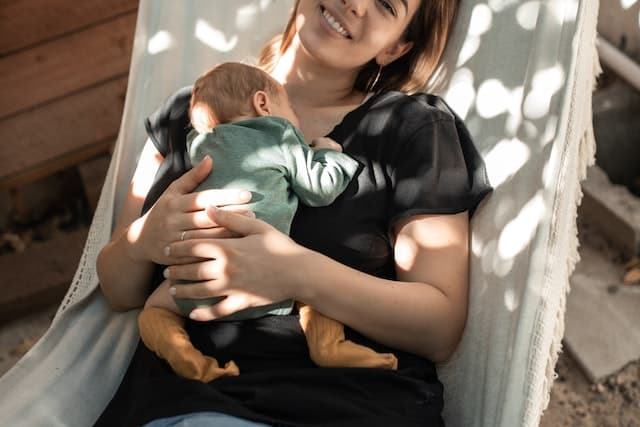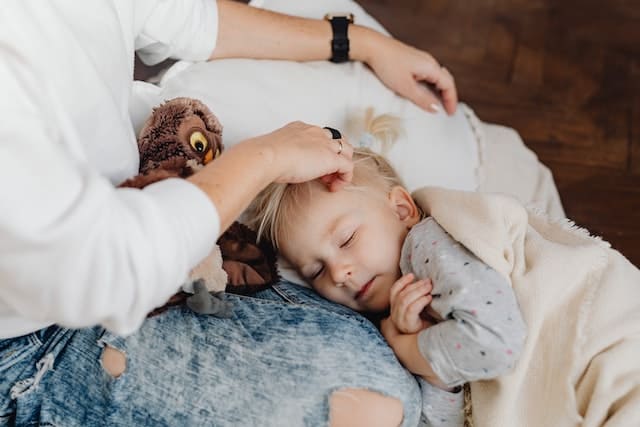Babies have a special way of melting our hearts, especially when they sleep. One of the most popular sleeping positions for babies is on their parent’s chest.
Many parents have experienced the joy of feeling their baby’s warm body nestled against their own, but have you ever wondered why babies love sleeping on chests?
Understanding baby sleep patterns is essential to answer this question. Babies have shorter sleep cycles than adults, which means they wake up more frequently during the night.
Additionally, babies spend more time in the REM stage of sleep, which is the lightest stage of sleep. This means they are easily disturbed by external factors such as noise or movement.
Despite these factors, babies feel safe and secure when sleeping on their parent’s chest. The feeling of a parent’s heartbeat, warmth, and scent can be soothing to a baby and help them fall asleep faster.
Additionally, the gentle rocking motion of a parent’s breathing can mimic the feeling of being in the womb, which can be comforting to a baby.
Key Takeaways
- Babies have shorter sleep cycles and spend more time in the lightest stage of sleep, making them easily disturbed by external factors.
- Sleeping on a parent’s chest can make a baby feel safe and secure, thanks to the feeling of a parent’s heartbeat, warmth, and scent.
- The gentle rocking motion of a parent’s breathing can mimic the feeling of being in the womb, which can be comforting to a baby.
Understanding Baby Sleep Patterns
Babies have a unique sleep pattern that is different from adults. Understanding baby sleep patterns is crucial for parents because it helps them identify when their child is tired and needs to sleep.
In this section, we will explore the different stages of baby sleep and how it affects their overall health and development.
Stages of Baby Sleep
Babies go through two main stages of sleep: REM (Rapid Eye Movement) and non-REM. REM sleep is when the baby’s eyes move rapidly, and they experience vivid dreams. Non-REM sleep is when the baby is in a deep sleep state and is not dreaming.
During the first few months of life, babies spend most of their time in REM sleep. As they get older, they spend more time in non-REM sleep. This is because non-REM sleep is essential for the baby’s physical and mental development.
The Importance of Baby Sleep
Sleep is crucial for a baby’s overall health and development. Lack of sleep can lead to irritability, fussiness, and even affect the baby’s immune system. It is essential to ensure that the baby is getting enough sleep each day.
Babies need more sleep than adults. On average, a newborn baby sleeps for 16-17 hours a day. As they get older, the amount of sleep they need decreases. By the time they are six months old, they need around 14-15 hours of sleep a day.
Napping
Napping is an essential part of a baby’s sleep pattern. Naps help the baby get the sleep they need during the day and can also help them sleep better at night. It is essential to establish a nap routine early on to ensure that the baby gets enough sleep during the day.
Sleep Training
Sleep training is a process that helps babies learn how to sleep on their own. It involves teaching the baby to fall asleep without the help of their parents. Sleep training can be a challenging process, but it is essential for the baby’s overall health and development.
In conclusion, understanding baby sleep patterns is crucial for parents. It helps them identify when their child is tired and needs to sleep. By establishing a sleep routine early on, parents can ensure that their baby is getting enough sleep each day.
Why Babies Love Sleeping on Chests
Babies have a natural inclination to sleep on their parents’ chests. This behavior is not only adorable but also has several benefits for both the baby and the parent.
One reason why babies love sleeping on chests is that it provides them with a sense of comfort and security. The warmth and softness of a parent’s chest create a comfortable and familiar environment for the baby, which helps them feel safe and protected.
The scent of the parent’s body also plays a significant role in this, as it helps the baby to recognize and bond with their parent.
Another reason why babies prefer sleeping on chests is that it allows them to experience skin-to-skin contact with their parent. This physical contact has been shown to have numerous benefits for both the baby and the parent.
It helps regulate the baby’s body temperature, heart rate, and breathing, and also promotes the release of oxytocin, a hormone that helps to strengthen the bond between parent and child.
Furthermore, the sound of a parent’s heartbeat can be soothing for a baby, as it reminds them of the rhythmic sound they heard in the womb. This sound can help the baby to relax and fall asleep more easily.
In summary, there are several reasons why babies love sleeping on their parents’ chests. The combination of comfort, warmth, scent, skin-to-skin contact, and the sound of a parent’s heartbeat creates a sense of security and familiarity that helps the baby to feel safe and protected.
Benefits of Chest Sleeping for Babies
Chest sleeping, also known as skin-to-skin contact, is a common practice among parents and their babies. This position involves placing the baby on the parent’s chest, with the baby’s head resting near the parent’s heart.
While this position may seem uncomfortable for the parent, there are several benefits to chest sleeping for babies.
Bonding and Attachment
Chest sleeping promotes bonding and attachment between the parent and baby. The close physical contact helps the baby feel safe and secure, which can lead to a stronger emotional bond between the two.
This bond can have long-lasting effects on the baby’s emotional development and can help them feel more confident and secure in the future.
Comforting and Relaxing
Chest sleeping can be very comforting and relaxing for babies. The warmth and scent of the parent’s body can help the baby feel calm and secure, which can lead to better sleep.
This can also help the baby feel more relaxed during the day, which can lead to better feeding and digestion.
Skin-to-Skin Contact
Chest sleeping is a form of skin-to-skin contact, which has been shown to have numerous benefits for babies. Skin-to-skin contact can help regulate the baby’s body temperature, heart rate, and breathing. It can also help the baby’s immune system develop, and can even help with breastfeeding.
Dad Involvement
Chest sleeping is not just for moms. Dads can also benefit from this practice, as it can help them bond with their baby and feel more involved in the caregiving process. Chest sleeping can also help dads feel more confident in their ability to care for their baby.
In conclusion, chest sleeping can provide numerous benefits for babies, including bonding and attachment, comforting and relaxing, skin-to-skin contact, and dad involvement.
Parents should feel confident in using this position as a way to promote their baby’s emotional and physical development.
Potential Risks of Chest Sleeping
While chest sleeping can be a comforting experience for both the baby and the parent, there are potential risks that should be considered.
Sudden Infant Death Syndrome (SIDS)
Sudden Infant Death Syndrome (SIDS) is a rare but serious risk associated with chest sleeping. The American Academy of Pediatrics recommends that infants should be placed on their backs to sleep, as this position has been shown to reduce the risk of SIDS.
It is important to note that chest sleeping is not the only factor that can increase the risk of SIDS, but it is one that should be taken into consideration.
Suffocation
There is a risk of suffocation when a baby is sleeping on a parent’s chest. This can occur if the parent accidentally rolls over onto the baby or if the baby’s face becomes pressed against the parent’s clothing or skin.
It is important to ensure that the baby’s airway remains clear and that the parent is always aware of the baby’s position.
Roll Off
Another risk associated with chest sleeping is the potential for the baby to roll off the parent’s chest and onto the bed or floor. This can be a dangerous situation, especially if the baby is still very young and unable to move or roll over on their own.
Reflux Issues
Babies with reflux issues may be more prone to spitting up or vomiting while sleeping on their parent’s chest. This can be uncomfortable for the baby and may increase the risk of choking or suffocation.
Colic
While chest sleeping can be comforting for babies with colic, it is important to note that it may not be the best solution for all babies. Some babies may become overstimulated or may have difficulty sleeping in this position, which can exacerbate colic symptoms.
Overall, while chest sleeping can be a comforting experience for both the baby and the parent, it is important to be aware of the potential risks and to take steps to minimize them.
Parents should always be aware of their baby’s position and should never sleep with their baby on a couch or other soft surface.
Safe Sleep Guidelines
Ensuring that a baby is sleeping safely is a top priority for any parent or caregiver. The American Academy of Pediatrics (AAP) has developed safe sleep guidelines to help reduce the risk of sudden infant death syndrome (SIDS) and other sleep-related deaths.
One of the most important guidelines is to always place a baby on their back to sleep, whether in a crib, bassinet, or other sleep space.
This position has been shown to reduce the risk of SIDS. It is also important to ensure that the sleep space is free of any soft objects, such as pillows or blankets, that could potentially suffocate the baby.
Additionally, the AAP recommends that babies sleep in the same room as their parents for at least the first six months of life, but not in the same bed. Co-sleeping, or sharing a bed with a baby, can increase the risk of suffocation or other sleep-related accidents.
When choosing a crib or bassinet, it is important to ensure that it meets current safety standards and guidelines. The mattress should fit snugly in the crib or bassinet, with no gaps that could potentially trap the baby. The crib or bassinet should also be free of any loose or broken parts.
It is important to note that the Moro reflex, or startle reflex, is a normal part of a baby’s development. However, it can cause a baby to startle and wake up during sleep.
Swaddling can help to reduce the effects of the Moro reflex, but it is important to follow safe swaddling guidelines and to stop swaddling once the baby shows signs of rolling over.
Overall, following safe sleep guidelines can help to ensure that a baby sleeps soundly and safely.
Alternatives to Chest Sleeping
While chest sleeping can be a comforting and bonding experience for both caregiver and baby, it may not always be practical or safe.
Here are some alternatives to consider:
Crib or Bassinet Sleeping
A crib or bassinet provides a safe sleeping environment for babies. It is recommended that infants sleep on their backs on a firm, flat surface with no soft objects or loose bedding.
The American Academy of Pediatrics recommends that infants sleep in the same room as their parents for at least the first six months of life to reduce the risk of Sudden Infant Death Syndrome (SIDS).
Swaddling
Swaddling is the practice of wrapping a baby snugly in a blanket. It can help soothe a fussy baby and promote sleep.
However, it is important to follow safe swaddling practices to reduce the risk of suffocation or hip dysplasia. The swaddle should be snug but not too tight, and the baby’s hips should be able to move freely.
White Noise
White noise can help create a calming environment for babies. It can also help drown out other noises that may disturb their sleep. There are many white noise machines and apps available, or caregivers can use a simple fan or humidifier.
Co-Sleeping
Co-sleeping is when a baby sleeps in the same bed as their caregiver. While this can be a convenient option for breastfeeding and bonding, it is important to follow safe co-sleeping practices to reduce the risk of SIDS and suffocation.
The baby should sleep on their back on a firm surface with no soft objects or loose bedding, and the caregiver should not be under the influence of drugs or alcohol.
Overall, there are many safe and effective alternatives to chest sleeping. It is important to find what works best for both the baby and caregiver, while also prioritizing safety and sleep hygiene.
Conclusion
In conclusion, babies like to sleep on their parents’ chests for several reasons. Firstly, it provides them with a sense of security and comfort as they can feel their parent’s heartbeat and warmth.
This can help them to relax and fall asleep faster. Secondly, it allows them to be close to their parent, which helps to strengthen the bond between them.
Moreover, sleeping on the chest can also help babies regulate their breathing and reduce the risk of sudden infant death syndrome (SIDS). This is because when a baby sleeps on their back, they may be more likely to experience breathing difficulties.
However, it is important to note that parents should always follow safe sleep guidelines and consult with their pediatrician if they have any concerns.
Overall, sleeping on the chest can be a beneficial and comforting experience for both the baby and parent. By understanding the reasons behind this preference, parents can provide their child with a safe and nurturing environment for sleep.
Related Posts:
Frequently Asked Questions
What are the benefits of letting a baby sleep on their tummy on your chest?
There are several benefits to letting a baby sleep on their tummy on your chest. Firstly, it can help regulate their breathing and heart rate, as they can feel the rise and fall of your chest.
Additionally, it can provide a sense of security and comfort for the baby, which can lead to longer and more restful sleep.
Why do babies prefer to sleep on your chest at night?
Babies prefer to sleep on your chest at night because it provides them with a sense of security and comfort. They can feel your warmth, hear your heartbeat, and smell your scent, which can all help them feel safe and relaxed.
Additionally, sleeping on your chest can help regulate their breathing and heart rate, which can lead to more restful sleep.
How long can a newborn safely sleep on your chest?
Newborns can safely sleep on your chest for short periods of time, such as during a nap or while you are sitting and holding them.
However, it is not recommended to let a baby sleep on your chest for extended periods of time, as it can increase the risk of suffocation or Sudden Infant Death Syndrome (SIDS).
Is it safe for a baby to sleep on your chest while you’re awake?
It is safe for a baby to sleep on your chest while you’re awake, as long as you are in a safe and comfortable position and are able to supervise the baby at all times. However, it is important to avoid falling asleep while holding the baby, as this can increase the risk of suffocation or SIDS.
What makes babies sleep better on your chest?
Babies sleep better on your chest because it provides them with a sense of security and comfort. They can feel your warmth, hear your heartbeat, and smell your scent, which can all help them feel safe and relaxed.
Additionally, sleeping on your chest can help regulate their breathing and heart rate, which can lead to more restful sleep.
Can a baby hear your heartbeat while sleeping on your chest?
Yes, a baby can hear your heartbeat while sleeping on your chest. This can provide them with a sense of security and comfort, as they are able to feel the rise and fall of your chest and hear the familiar sound of your heartbeat.
Learn more about swaddling: How Tight Should a Swaddle Be

Iesha is a loving mother of 2 beautiful children. She’s an active parent who enjoys indoor and outdoor adventures with her family. Her mission is to share practical and realistic parenting advice to help the parenting community becoming stronger.



